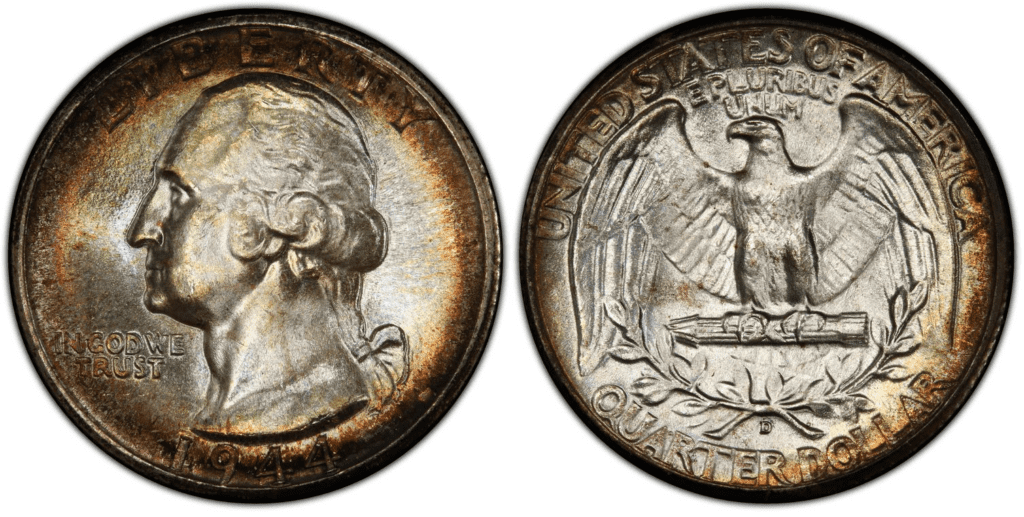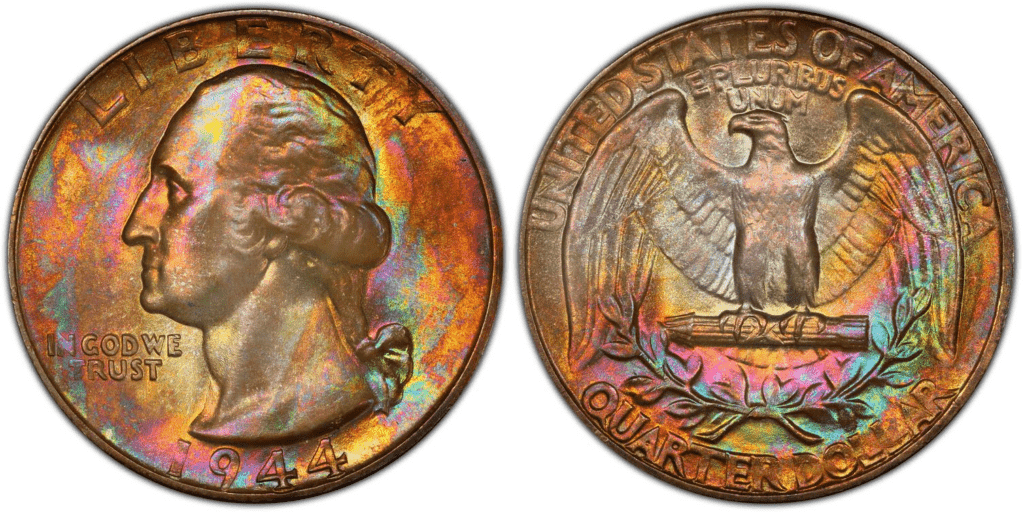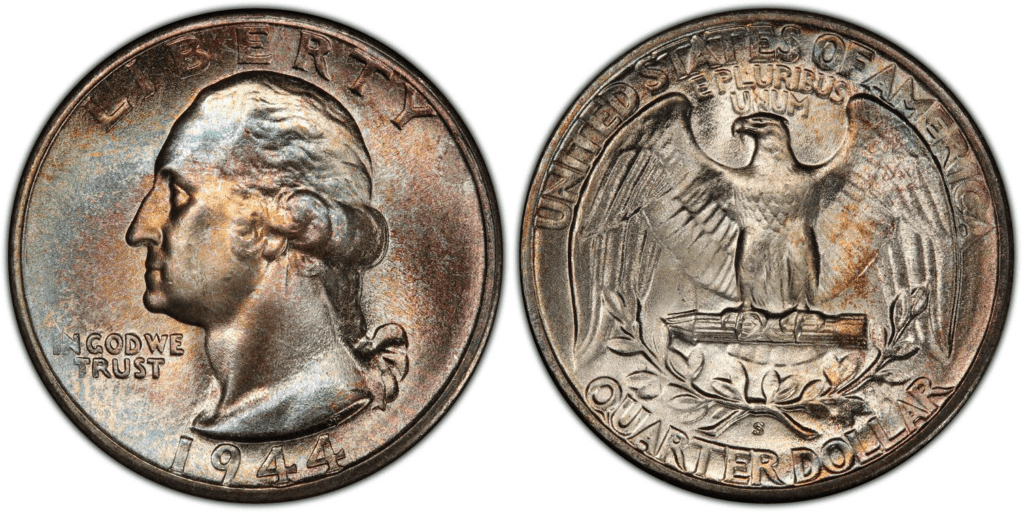What Is the 1944 Washington Silver Quarter Made Of?
The 1944 Washington silver quarter is among the most interesting coins to collect. Many coin enthusiasts look for it because of its premium value and composition. As silver bullion, it is more likely to be worth more than its face value.
While the US quarter coin has been struck on and off since 1796, it was only in 1932 that it received the Washington design. The 1944 Washington silver quarter is just one of the several-year series of the Washington 25-cent.
For its composition, the 1944 quarter is made of 90% silver and 10% copper. This has been the composition of the Washington quarter from 1932 to 1964. However, from 1965 to the present, the Washington 25-cent transitioned to copper and nickel.
There have been a few reasons why the transition happened. The primary reason was that silver coins were getting more and more expensive to produce. Thus, there came a time when producing the Washington quarter was even more expensive than its face value.
This increased the perceived intrinsic value of the Washington quarter. Since silver is getting more expensive, people would rather hoard it than spend it.
All these made the US Mint and Congress decide to turn all silver coins into base metals through the Coinage Act of 1965.
In regards to its design, the original version of the Washington quarter was prepared by John Flanagan. This was done in relation to Washington’s bicentennial birthday, which would occur in 1932. To honor the first president of the United States, the quarter coin was chosen to bear Washington’s image.
The obverse of the 1944 quarter coin features a picture of Washington facing to the left. Inscriptions include LIBERTY, IN GOD WE TRUST, and 1944.

On the reverse, the 1944 quarter coin features the heraldic bald eagle with its wings spread out. On top of the eagle’s head, you’ll find the US motto, E PLURIBUS UNUM. On top of the coin arches the inscription “UNITED STATES OF AMERICA” while at the bottom arches “QUARTER COIN.”
Other elements are also present. For example, the bird holds in its talon a bundle of arrows, which signifies the readiness of the United States to defend itself. The olive branch below the arrows represents the American’s love for peace.
1944 Washington Silver Quarter Varieties
The 1944 Washington silver quarter comes in different varieties. These varieties basically differ from each other based on their mintmarks. There are three officially released varieties of the 1944 Washington quarter. These include the 1944-D, 1944-P (no mint mark), and 1944-S Washington quarter.
Here’s a quick breakdown of the mintage figures of the 1944 Washington quarter based on the variety:
| Variety | Mint Center | Type | Mintage |
| 1944-D quarter | Denver | Regular strike | 14,600,800 |
| 1944-P quarter | Philadelphia | Regular strike | 104,956,000 |
| 1944-S quarter | San Francisco | Regular strike | 12,560,000 |
| Total | 132,116,800 |
There are a total of more than 132 million quarter coins produced in 1944. This is a higher mintage figure compared to what was produced in 1943 and even in 1945.
Aside from the regularly struck 1944 quarter coins, there are also some error coins that came out from the mint center. This gave rise to a different variety or type within the series.
To learn more, here are the officially issued 1944 quarter coins:
1944 D Washington Silver Quarter
Edge: Reeded
Mint Mark: D
Place of minting: Denver
Year of minting: 1944
Face Value: $0.25 (twenty-five cent)
Price: $15 to $36 (or more)
Quantity produced: 14,600,800
Designer: John Flanagan
Composition: 90% silver and 10% copper
Mass: 6.30 grams
Diameter: 24.3 millimeters
Thickness: 1.75 millimeters

photo source: PCGS
The 1944 D Washington quarter was struck in the Denver Mint. You’ll know that a quarter coin is from Denver when it has a D mint mark. All 1944 quarters struck in Denver bear the D mint mark. At the end of 1944, the Denver Mint produced more than 14.6 million quarter coins. From 1942, the mintage trend decreased, and this continued until 1946.
The 1944-D variety of the Washington quarter coin is among the more sought-after issues in the Washington series. The coins from this series look more beautiful than the usual quarters. This variety displays a more impressive luster because the Denver Mint used freshly made dies.
Thus, you should be able to find 1944-D with grades up to MS67 easily. However, MS68 to MS70 grades are scarce and difficult to find. The typical price of circulated and uncirculated 1944-D quarters may be around $15 to $36.
1944 P Washington Quarter
Edge: Reeded
Mint Mark: No mint mark
Place of minting: Philadelphia
Year of minting: 1944
Face Value: $0.25 (twenty-five cent)
Price: $9 to $16 (or more)
Quantity produced: 104,956,000
Designer: John Flanagan
Composition: 90% silver and 10% copper
Mass: 6.30 grams
Diameter: 24.3 millimeters
Thickness: 1.75 millimeters

photo source: PCGS
The Philadelphia Mint produced the most number of 1948 quarters with more than 100 million mintage figures. This is actually the highest mintage of quarter coins until 1962. The price would usually hover around $9 to $16.
You can easily find up to MS67-graded 1944-P quarters. MS68 to MS70 quarter coins are quite scarce.
1944 S Washington Quarter
Edge: Reeded
Mint Mark: S
Place of minting: San Francisco
Year of minting: 1944
Face Value: $0.25 (twenty-five cent)
Price: $11 to $41 (or more)
Quantity produced: 104,956,000
Designer: John Flanagan
Composition: 90% silver and 10% copper
Mass: 6.30 grams
Diameter: 24.3 millimeters
Thickness: 1.75 millimeters

photo source: PCGS
The 1944 S Washington quarter was struck in the San Francisco Mint. All 1944 quarters struck in San Francisco bear the S mint mark. The San Francisco Mint produced 12,560,000, less than what was struck in 1943 and 1945.
The good news is that there were plenty of well-struck quarter coins from the Washington Mint in 1944. Of course, there were still coins that were poorly struck. These coins showed blurred details and heavy erosion lines.
Price may range from $11 to $41. 1944-S is quite common up to MS67 grade.
List of 1944 Washington Quarter Errors
As mentioned above, more than 132 million Washington quarters were struck in 1944. So, it should not be surprising to note that a few quarter coins are struck with errors.
While there are different error types in the series, the most common and known error is the DDO or doubled-die obverse. This error is usually seen from the quarters struck in the Philadelphia Mint.
DDO errors happen when the planchet is struck by the die twice. Because of that, you will see some doubling in some engraved elements. The double is frequently seen in the letters and numbers of the quarter coins. When it says “DDO,” it means that the error is found on the obverse side. If the error is on the reverse, it is called “DDR.”
DDO and DDR errors aren’t always obvious. In most cases, you would need a magnifying glass or microscope to detect the error. The more prominent the error is the higher the coin’s value in the collectors’ eyes.
Of course, aside from DDO, there are other errors that usually happen during the minting process. One example would be the off-center strike when the die didn’t hit the center of the planchet.
There’s also the broadstrike error when the collar holding the planchet doesn’t work properly. So, when the die hits the coin, the collar doesn’t effectively hold the coin, and the planchet spreads like a pancake.
How Much Is The 1944 Washington Silver Quarter Worth Today?
The 1944 Washington silver quarter has a face value of 25 cents. Its melt value is slightly higher since it is made of silver. The melt value reaches as high as $4.3440, which can increase or decrease based on the market value of silver.
Nevertheless, the 1944 Washington silver quarter can be higher depending on the rarity, condition, and grade.
To get more idea of the value of this coin, here’s a 1944 Washington Silver Quarter values chart:
| Coin | Condition | Grade | Mintage | Value |
| 1944 D Washington Quarter | Circulated/mint | Not graded | 16,766,800 | $8 to $10 |
| 1944 D Washington Quarter | Uncirculated/mint | MS-66 | 16,766,800 | $39 to $950 |
| 1944 D Washington Quarter | Uncirculated/mint | MS-67 | 16,766,800 | $169 to $375 |
| 1944 D Washington Quarter | Uncirculated/mint | MS-68 | 16,766,800 | $1,643 to $10,575 |
| 1944 P Washington Quarter | Circulated/mint | Not graded | 35,196,000 | $7.50 to $8
|
| 1944 P Washington Quarter | Uncirculated/mint | MS-66 | 35,196,000 | $22 to $55 |
| 1944 P Washington Quarter | Uncirculated/mint | MS-67 | 35,196,000 | $159 to $372 |
| 1944 P Washington Quarter | Uncirculated/mint | MS-68 | 35,196,000 | $9,600 to $16,800 |
| 1944 S Washington Quarter | Circulated/mint | Not graded | 15,960,000 | $8 to $10
|
| 1944 S Washington Quarter | Uncirculated/mint | MS-66 | 15,960,000 | $36 to $75 |
| 1944 S Washington Quarter | Uncirculated/mint | MS-67 | 15,960,000 | $144 to $312 |
| 1944 S Washington Quarter | Uncirculated/mint | MS-68 | 15,960,000 | $2,174 to $16,100 |
:
As you can see, the 1944 quarter can be very expensive. You can also take a look at the auction record for each variety to really appreciate how valuable the 1944 quarter can be:
- $16,800 – a 1944 25C (Regular Strike) coin with a grade of MS68 sold in August 2022 by Heritage Auctions
- $16,100 – a 1944-S 25C (Regular Strike) coin with MS68 CAC sold in March 2011 by Stack’s Bowers
- $10,575 – a 1944-D 25C (Regular Strike) coin with a grade of MS68 sold in August 2015 by Heritage Auctions
How Does The Grading System Work?
The Sheldon Scale is used by numismatists to provide a numerical value to coins. The Sheldon Scale goes from poor (P-1) to perfect mint state (P-1) (MS-70). Coins were originally evaluated using words to reflect their condition (Good, Fair, Excellent, Etc.). Unfortunately, coin collectors and dealers had different ideas about what each of these terms represent.
Professional numismatists joined together in the 1970s and established CoinGrading standards. These numismatists now assign grades at key places on the seventy-point scale, using the most regularly utilized numeric points in conjunction with the original adjective grade. The following are the most common coin grades:
-
-
- (P-1) Poor – Indistinguishable and probably damaged; if used, must have a date and mintmark; otherwise, rather battered.
- (FR-2) Fair – Nearly smooth, but without the damage that a coin graded Poor often possesses. The coin must have enough detail to be identified.
- (G-4) Fair – Inscriptions have merged into the rims in some areas, and important elements have been mostly erased.
- (VG-8) Very Good- A little weathered, but all of the primary design elements are visible, albeit faintly. There is little if any, central detail left.
- (F-12) Good – The item is very worn, yet the wear is even, and the overall design details stand out clearly. Rims are almost completely isolated from the field.
- (VF-20) Very Fine – Moderately weathered, with some finer features still visible. The motto or all letters of LIBERTY are readable. Both sides of the coin have entire rims that are separated from the field.
- (EF-40) Extremely Fine – Gently used; all gadgets are visible, and the most important ones are bold. The finer details are bold and clear, however, light wear may be seen.
- (AU-50) Uncirculated – Slight evidence of wear on the coin’s design’s high points; may have contact marks; eye appeal should be adequate.
- (AU-58) Uncirculated Choice – Slight traces of wear, no severe contact marks, almost full mint shine, and great eye appeal.
- (MS-60) Mint State Basal – Strictly uncirculated; no indication of wear on the coin’s highest points, but an unsightly coin with reduced luster, visible contact marks, hairlines, and other flaws.
- (MS-63) Mint State Acceptable – Uncirculated, but with contact scratches and nicks, little reduced shine, but otherwise appealing appearance. The strike is weak to average.
- (MS-65) Mint State Choice – Uncirculated with great mint shine, very little contact blemishes, and exceptional eye appeal. The strike is unusually severe.
- (MS-68) Mint State Premium Quality – Uncirculated with superb luster, no obvious contact marks to the naked eye, and exceptional eye appeal. The strike is quick and appealing.
- (MS-69) Almost Perfect Mint State – Uncirculated with perfect brilliance, a sharp and appealing strike, and extremely good eye appeal. A near-perfect coin with minor imperfections in the planchet, strike, and contact markings (seen only under 8x magnification).
- (MS-70) Mint State Perfect – Under 8x magnification, there are no tiny imperfections discernible; the strike is crisp, and the coin is perfectly centered on a beautiful planchet. Rarely seen on a coin, this coin is bright and whole, with original luster and exceptional eye appeal.
-
Where To Buy Or Sell 1944 Washington Silver Quarter?
The 1944 Washington silver quarter is available both online and offline. You can go to Amazon, eBay, and even Etsy to find the coin you’re looking for. You can also head to websites that specialize in buying and selling coins. Some examples include JM Bullion, Grey Sheet, and USA Coin Book.
If you’re not into going online but you want to see or touch the coin physically, you can definitely visit coin shops, antique stores, and pawnshops. These places are known to both buy and sell silver coins. You can also join auctions, which are known to offer some of the rarest US coins.
FAQs
Are 1944 quarters all silver?
The 1944 quarters are not all silver. Instead, it is made of 90% silver and 10% copper.
How much does a 1944 silver quarter weigh?
The 1944 silver quarter weighs 6.30 grams, slightly heavier than the modern quarter coins today.
Where is the mint mark on a 1944 silver quarter?
The mint mark of the 1944 silver quarter can be found on the coin’s reverse side. Look for the mint mark above the second letter R in the word “quarter.” If present, the mint mark you’ll find would be either S or D.



